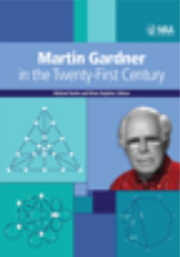Book contents
- Frontmatter
- Preface
- Contents
- I Geometry
- II Number Theory and Graph Theory
- III Flexagons and Catalan Numbers
- 12 It's Okay to Be Square If You're a Flexagon
- 13 The V-flex, Triangle Orientation, and Catalan Numbers in Hexaflexagons
- 14 From Hexaflexagons to Edge Flexagons to Point Flexagons
- 15 Flexagons Lead to a Catalan Number Identity
- 16 Convergence of a Catalan Series
- IV Making Things Fit
- V Further Puzzles and Games
- VI Cards and Probability
- VII Other Aspects of Martin Gardner
- Index
- About the Editors
12 - It's Okay to Be Square If You're a Flexagon
from III - Flexagons and Catalan Numbers
- Frontmatter
- Preface
- Contents
- I Geometry
- II Number Theory and Graph Theory
- III Flexagons and Catalan Numbers
- 12 It's Okay to Be Square If You're a Flexagon
- 13 The V-flex, Triangle Orientation, and Catalan Numbers in Hexaflexagons
- 14 From Hexaflexagons to Edge Flexagons to Point Flexagons
- 15 Flexagons Lead to a Catalan Number Identity
- 16 Convergence of a Catalan Series
- IV Making Things Fit
- V Further Puzzles and Games
- VI Cards and Probability
- VII Other Aspects of Martin Gardner
- Index
- About the Editors
Summary
It has been said that a mathematician can be content with only paper and pencil. In fact, there are times when one doesn't even need the pencil. From a simple strip of paper it is possible to make a surprisingly interesting geometric object, a flexagon. The flexagon can credit its creation to the difference in size between English-ruled paper and American binders. The father of the flexagon, Arthur Stone, was an English graduate student studying at Princeton University in 1939. To accommodate his smaller binder, Stone removed strips of paper from his notebook sheet. Not being wasteful, he creased these lengths of paper into strips of equilateral triangles, folded them in a certain way, and taped their ends. Stone noticed that it was possible to flex the resulting figure so that different faces were brought into view—and the flexagon was born [1]. Stone and his colleagues, Richard Feynman, Bryant Tucker, and John Tukey, spent considerable time cataloging flexagons but never published their work.
Like many geometric objects, flexagons can be appreciated on many levels of mathematical sophistication (the first author remembers folding flexagons in elementary school). With so adaptable a form, it is not surprising that flexagons have been studied from points of view that vary from art to algebra. Our interest in flexagons was sparked by a question posed in a paper by Hilton, Pedersen, and Walser [9]. They studied one of the hexaflexagons, so-named because the finished model has the shape of a hexagon.
- Type
- Chapter
- Information
- Martin Gardner in the Twenty-First Century , pp. 87 - 102Publisher: Mathematical Association of AmericaPrint publication year: 2012



